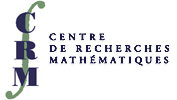 |
|
||||
Org: Florin Diacu (Victoria), Renato Itturiaga (CIMAT) and Ernesto Pérez-Chavela (UAM)
[PDF]
- CAROLINE ADLAM, Dalhousie University, Halifax, Nova Scotia
The equivalence problem for Killing tensors defined on spaces of constant curvature [PDF] -
Beginning with the classic 1950 paper by M. N. Olevksii, the study of canonical characteristic Killing tensors of valence two defined on three-dimensional spaces of constant (non-zero) curvature has been thoroughly investigated in the literature. However, there is yet no general theory concerning the solvability of the corresponding equivalence problem.
Thus, we present a solution to the equivalence problem by applying the invariant theory of Killing tensors developed in recent years. In particular, we use the isometry group representation in the vector spaces of Killing two-tensors and apply the resulting invariants and covariants to characterize the orbits corresponding to the characteristic Killing two-tensors.
To illustrate our results, we apply our theory to Hamiltonian systems whose associated Hamilton-Jacobi equation is solvable by orthogonal separation of variables.
- AUBIN ARROYO, U. Cuernavaca, I. de Matematicas, UNAM
C2-robustly transitive diffeomorphisms on surfaces with boundary [PDF] -
Robustly transitive maps can not be ignored in any global picture of dynamical systems. Besides being a property that cannot be destroyed by small perturbations, the maps that have it often exhibit a chaotic dynamical behavior. This property is widely studied in the C1-topology, and it is related to hyperbolicity and transversality properties. Few things are known in the C2-topology. In this talk we shall exhibit a class of smooth diffeomorphisms on a compact surface with boundary which are robustly transitive in the C2-topology but not in the C1-topology.
- LENNARD BAKKER, 346 TMCB, Brigham Young University, Provo, UT 84602, USA
Linear Stability of Some Symmetric Periodic Simultaneous Binary Collision Orbits in the Four-Body Problem [PDF] -
Recently, Roberts developed a method for analyzing the linear stability of time-reversible periodic solutions of a Hamiltonian system. He used this method to determine the linear stability of the figure eight orbit in the equal mass three-body problem. We use Robert's method to determine the linear stability of time-reversible periodic simultaneous binary collision orbits in the symmetric collinear four-body 1,m,m,1 problem, and in the two-dimensional symmetric equal mass four-body problem.
- MARTIN CELLI, Universidad Autónoma Metropolitana-Iztapalapa, Mexico City
Polygonal relative equilibria in the N-vortex problem [PDF] -
The N-vortex problem consists in the study of the solutions of the equations of Helmholtz which describe the motion of a planar incompressible fluid.
We are interested in relative equilibria made of regular polygons. We show that a relative equilibrium with one polygon with more than three vortices requires equal vorticities. This result is the analogous of Perko-Walter's one in celestial mechanics. We compute the relative equilibria with two polygons and the same vorticity on each polygon. We also study the corresponding restricted problem.
This work adapts and generalizes results of Aref-Van Buren (two polygons with the same vorticity for all the vortices) and Moeckel-Simó (two polygons in celestial mechanics).
This is a joint work with Ernesto Lacomba and Ernesto Pérez-Chavela.
- MONICA COJOCARU, University of Guelph, Guelph, ON, N1G 2W1
Hybrid dynamical systems and dynamics of networks and games [PDF] -
We present a hybrid systems approach to describing the time evolution of a class of network equilibrium problems and noncooperative games. Our method is blends in with previous approaches for studying equilibrium problems, coming from optimization and complementarity problems, but brings new understanding of dynamics for certain classes of equilibrium problems.
This is joint work with Scott Greenhalgh, University of Guelph.
- JOAQUIN DELGADO, Departamento de Matemáticas, UAM-Iztapalapa
The Bogdanov-Takens bifurcation in a class of traffic flow models [PDF] -
Macroscopic traffic models are based in the analogy with a continuous 1-dimensional flow. Conservation of number of cars leads to conservation of mass and the Navier-Stokes equation
where r(t,x) is density, V(t,x) the average velocity of cars, h the "viscosity" and p the local pressure, being proportional to the variance ("temperature") of the traffic Q(x,t) and to the gradient velocity; in the simplest case p = q0 r- h0 [(¶V)/(¶x)] with constants Q0, h0. The "external forces" in the Kerner-Konhauser are represented by driver's tendency to acquire a safe velocity Ve(r) with a relaxation time t, X = r[(Ve(r)-V)/(t)], where Ve(r) is the empirical "fundamental relationship" usually a monotone decreasing function bounded from below.\tag1 ¶r ¶t+ ¶rV ¶x= 0 (1) \tag2r æ
è¶V ¶t+ V ¶V ¶xö
ø= ¶ ¶xæ
èh ¶V ¶xö
ø- ¶p ¶x+ X (2) By performing the change of variables z=x+vgt, solutions of (1) in the form of travelling waves are reduced to: r(v+vg) = qg with parameters vg, qg, and solutions of (2) are reduced to a dynamical system, written in adimensional variables as
Here ve(v) is de adimensional version of Ve(r).\tag3 dv dz= y dy dz= lqg é
ë1 - q0 (v+vg)2ù
ûy - mqg æ
ève(v)-v v+vgö
ø. (3) We prove that there exist a curve in the parameter space vg-qg-Q0 such that system (3) undergoes a Bagdanov-Takens bifurcation. In particular we prove the existence of Hopf and homoclinic bifurcations.
This is a joint work with Patricia Saavedra and Rosa María Velasco (UAM-I).
- FLORIN DIACU, University of Victoria, PO Box 3060, STN CSC
The n-body problem in spaces of constant curvature [PDF] -
In the 1830s, Bolyai and Lobachevsky independently extended cal 2-body problem to spaces of negative constant curvature. Their work was continued by other mathematicians, including Lipschitz and Killing, who also considered the positive-curvature case. Schroedinger and Infeld later developed a quantum-mechanical analogue. But in spite of many recent results obtained in this direction by the Russian school of celestial mechanics, the problem was never generalized to more than 2 bodies. The goal of this talk is to derive the equations of motion of the n-body problem in spaces of constant curvature and to present some of the interesting properties these equations have. Among them are certain solutions that provide some new criteria towards understanding the large-scale geometry of the physical space.
- ANTONIO GARCIA, UAM-IZTAPALAPA
Asymptotic properties of some non-Markovian stochastic processes [PDF] -
We study the limit behavior of certain classes of dependent random sequences (processes) which do not possess the Markov property. We remark the differences between the Markovian and our problem. Assuming the dependence of the non-Markovian processes depend on a control parameter we show that the optimization of the control can be reduced to a problem of nonlinear optimization. Under certain hypotheses we establish the stability of such optimization problems.
- ADOLFO GUILLOT, UNAM, Instituto de Matematicas, Cuernavaca
Complex differential equations with single-valued solutions [PDF] -
We will talk about recent work in collaboration with Julio Rebelo dealing with semicomplete meromorphic vector fields on complex surfaces, that is, vector fields whose solutions are single-valued in restriction to the open set where the vector field is holomorphic. We will show that, up to a birational transformation, a compact connected component of the divisor of poles is either a rational or elliptic curve of vanishing self-intersection or has the combinatorics of a singular fiber of an elliptic fibration. This implies that up to a birational transformation, a semicomplete meromorphic vector field on a compact complex projective surface is either holomorphic, has a first integral or preserves a fibration. This extends to semicomplete polynomial vector fields in C2 the results established by Brunella for complete ones.
- RENATO ITURRIAGA, Cimat
Hyperbolicity and exponential convergence of the Lax Operator [PDF] -
The Lax operator gives the solution of the evolution Hamilton-Jacobi equation. It is a result of Fathi that in the Hamiltonian is autonomous the evolution process converges to solution of the static Hamilton-Jacobi equation. We prove that if the Aubry set is hyperbolic this convergence is exponential.
- RAY MCLENAGHAN, University of Waterloo, Department of Applied Mathematics, Waterloo, Ontario N2L 3G1
Symmetry operators for the Dirac equation on 2-dimensional Riemannian spin manifolds [PDF] -
The second-order symmetry operators for the Dirac equation on 2-dimensional Riemannian spin manifolds are determined in terms of Killing vectors and valence two Killing tensors defined on the underlying manifold. The role of these operators in the theory of separation of variables for the Dirac equation is described.
Joint work with Lorenzo Fatibene, Giovanni Rastelli, and Shane Smith.
- ERNESTO PÉREZ-CHAVELA, Universidad Autonoma Metropolitana-Iztapalapa, Av. San Rafael Atlixco 186, Mexico, D.F. 09340, Mexico
Central Configurations in the four body problem with some equal masses [PDF] -
A central configuration in the N-body problem is a particular position of the N-particles where the acceleration vector of each particle is proportional to the corresponding position vector, and the constant of proportionality is the same for the N-particles. In this talk we study the central configurations in the four body problem when three or two of the masses are equal. We prove that there is an unique convex central configurations when two equal masses are located at opposite vertices of a quadrilateral. If three of the masses are equal and the configuration possesses a symmetry line, we find the total number of central configurations.
- MANUELE SANTOPRETE, Wilfrid Laurier University
Toward Bertrand's theorem for surfaces of revolution [PDF] -
In classical mechanics, Bertrand's theorem states that the only two types of central potentials for which all the bounded orbits are closed are the gravitational potential and the harmonic oscillator potential. In this talk I will consider the motion of a particle on a surface, under the influence of a central force field, and I will discuss Bertrand's theorem in the case of surfaces of revolution. I will present some results and some open questions.
- CRISTINA STOICA, Wilfrid Laurier University, 75 Univ. Ave West, Waterloo, ON, N2L 3C5
Normal forms for Hamiltonian systems with symmetry [PDF] -
This talk presents results concerning the Birkhoff normal forms theory for Hamiltonian systems with non-commutative continuous symmetries around a relative equilibrium.
An appropriate slice theorem is used to locally decompose the phase space into the drift and slice directions, that is, coordinates along the symmetry group and complementary directions, respectively. The dynamics is described by a skew product system where the slice dynamics, a Hamiltonian system in the Poisson sense, drives the drift. The normal form for the slice equations is achieved by using structure preserving (Poisson) changes of coordinates. Further, the normalization of the slice equations induces the normalization of the drift equations.
This work is joint with Mark Roberts (Univ. of Surrey, UK) and Tanya Schmah (U of T).
- ALBERTO VERJOVSKY, Instituto de Matematicas, Unidad Cuernavaca, Universidad Nacional Autonoma de Mexico
Holomorphic dynamical systems whose orbit spaces give new examples of compact complex manifolds [PDF] -
We consider in Cn a system of m commuting linear ODE (2m+1 < n) given by m commuting matrices A1,...,Am. Under some generic and arithmetic conditions, the (semi-stable) orbit spaces of the Cm ×C* action generated by the commmuting equations, together with the action of multiplication of scalars in C*, give compact, complex manifolds that fiber over toric varieties. We indicate the proof that every nonsingular toric variety is obtained this way.
In this talk I will describe joint work with Laurent Meersseman.
- CARLOS VILLEGAS, Universidad Nacional Autonoma de Mexico, Avenida Universidad S/N, Col. Lomas de Chamilpa, Cuernavaca Morelos, 62210, MEXICO
On the regularization of the Kepler and Coulomb problems [PDF] -
We describe two known regularizations of the Kepler problem: The Moser and the Kustaanheimo-Stiefel regularizations. By considering the quantization of a canonical transformation relating both regularizations, we define a Bargmann-type transform and as a consequenece a set of coherent states for the Hilbert space of square integrable functions on the 3-sphere and the hydrogen atom problem with negative energy. We describe asymptotics for clusters of eigenvalues for suitable perturbations of the hydrogen atom problem. We will describe the geometry of the above-mentioned canonical transformation involving two moment maps of related Lie groups.






